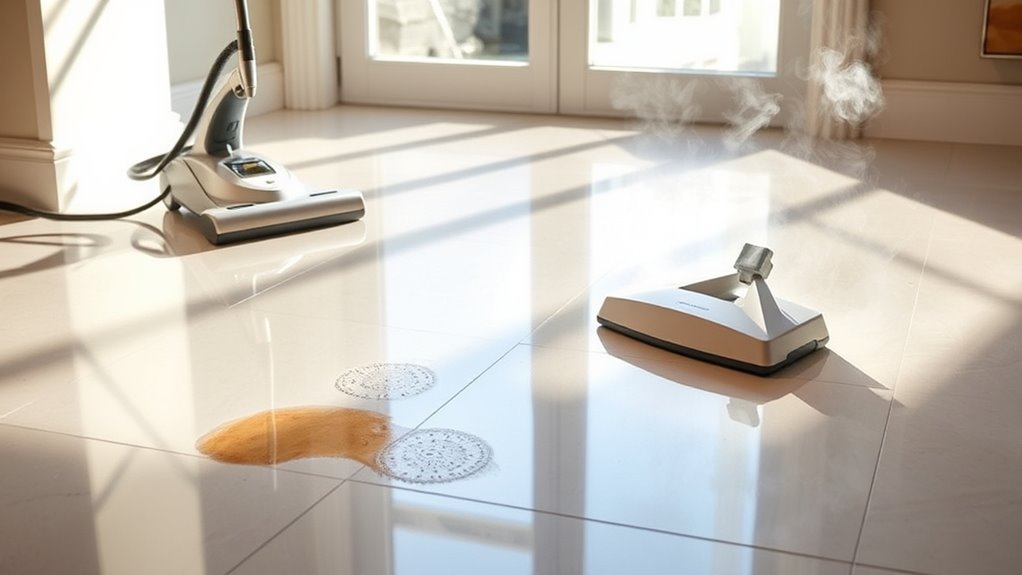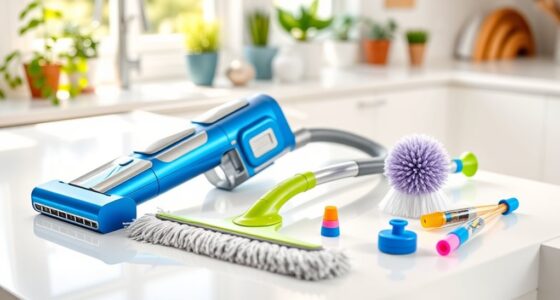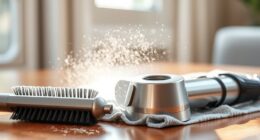Steam cleaning floors is an eco-friendly, efficient way to sanitize your surfaces and eliminate allergens. You benefit from a chemical-free method that tackles dirt and stains effectively. However, it’s not suitable for all flooring types, like unsealed wood or certain laminate. Overuse can lead to moisture issues, like mold and mildew growth. To guarantee the best results and avoid pitfalls, you might want to explore what’s right for your home and flooring.
Key Takeaways
- Pros: Steam cleaning is eco-friendly, using high-temperature water vapor to effectively sanitize and remove dirt without harmful chemicals.
- Pros: It eliminates allergens like dust mites and pet dander, improving indoor air quality for healthier living spaces.
- Cons: Not suitable for unsealed wood and vinyl flooring, as it may cause damage or warping.
- Cons: Initial cost of steam mops is higher compared to traditional mops, which may deter some users.
- Cons: Improper use can lead to moisture buildup, fostering mold and mildew growth if not managed correctly.
Understanding Steam Cleaning
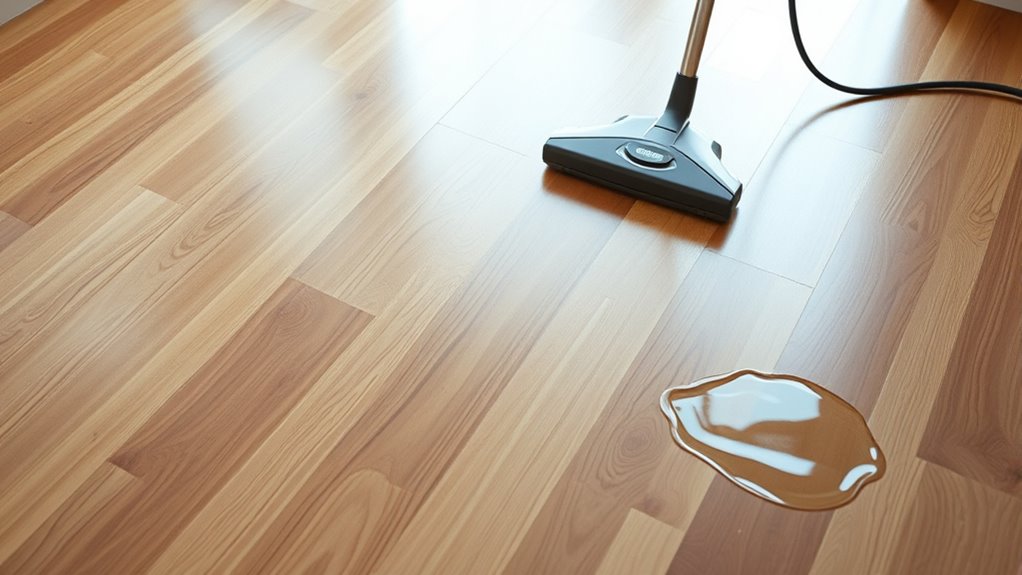
Steam cleaning is an effective and eco-friendly method for cleaning various surfaces in your home. By using high-temperature water vapor, steam cleaning removes dirt, grime, and stains while sanitizing surfaces without harsh chemicals. This process heats water to 212°F (100°C), creating pressurized steam that loosens dirt and kills harmful microorganisms on contact. You can use steam cleaning on a variety of surfaces, including tile and sealed hardwood floors, making it a versatile choice among cleaning methods. Additionally, regular cleaning with steam can help reduce allergens and improve indoor air quality, similar to the benefits of air purifiers. Using steam cleaning on tile and sealed surfaces can enhance the longevity of your flooring by preventing the buildup of dirt and grime. Regular maintenance of your steam cleaner, like filter cleaning, is essential for optimal performance. Moreover, incorporating proper watering techniques for large indoor plants can also aid in maintaining a clean and healthy home environment.
However, be cautious—using steam on unsealed surfaces can cause damage. Also, avoid overusing steam in one area and remember to clean the water tank after each use to maintain peak performance.
Understanding these aspects will help you utilize steam cleaning effectively.
Benefits of Steam Cleaning Floors
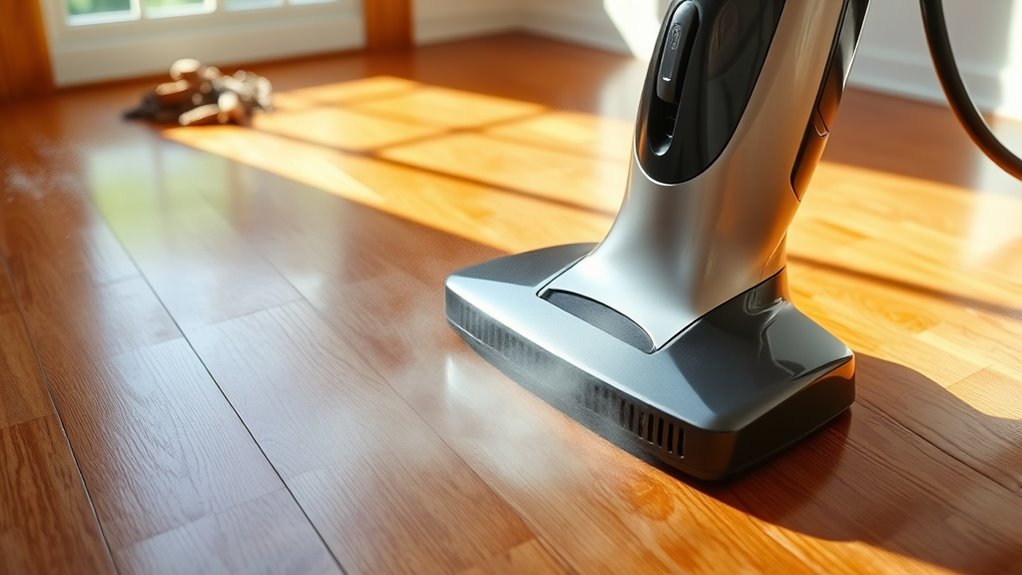
When you choose steam cleaning for your floors, you’re opting for a chemical-free cleaning method that’s both safe for your family and pets. This powerful technique not only sanitizes surfaces effectively but also eliminates harmful microorganisms, ensuring a healthier living space. With steam cleaning, you can tackle stubborn dirt and stains while keeping your home environmentally friendly. Additionally, using air purifiers after steam cleaning can further enhance indoor air quality by removing residual particles and allergens. Moreover, incorporating essential oils into your cleaning routine can provide pleasant fragrances and additional antibacterial properties. Regular use of essential oils for hair growth can also promote a calming environment, making your cleaning experience even more enjoyable. To maximize the benefits of steam cleaning, consider using a model with HEPA filtration, which can capture fine dust and allergens released during the cleaning process.
Chemical-Free Cleaning Advantage
Using high-temperature water vapor instead of harsh chemicals, steam cleaning offers a safer solution for homes with children and pets.
This chemical-free cleaning method effectively removes dirt and grime while eliminating up to 99.9% of harmful microorganisms, including bacteria and allergens. Regular use of steam cleaning can also improve indoor air quality, reducing the risk of triggering allergies or respiratory issues. Additionally, steam cleaning can be particularly effective at removing stubborn stains from various surfaces, enhancing the overall cleanliness of your home.
Moreover, by using just water, steam cleaning minimizes your household’s chemical exposure, promoting a healthier environment for everyone. It’s also eco-friendly, cutting down on the harmful impact of chemical cleaners on ecosystems. Furthermore, steam cleaning can support mental clarity by providing a clean and organized living space that contributes to a more serene atmosphere.
Regular steam cleaning not only keeps your surfaces clean but also helps eliminate lingering odors, providing a fresh atmosphere. Moreover, this method aligns with environmental sustainability practices by reducing reliance on chemical cleaning agents.
Effective Sanitization Benefits
Maintaining a clean and healthy environment goes beyond just chemical-free methods; effective sanitization is essential for your floors. Steam cleaning can kill up to 99.9% of harmful microorganisms without using harsh chemicals. The high temperature of steam, reaching up to 245 degrees Fahrenheit, not only cleans but also disinfects surfaces, especially in high-germ areas like kitchens and bathrooms. Additionally, using steam cleaning can help alleviate feelings of isolation in seniors who may struggle with traditional cleaning methods as it requires less physical exertion and digital literacy programs can promote playful communication around home care. Furthermore, steam cleaning effectively eliminates harmful microorganisms that may linger on surfaces, adding an extra layer of protection for your home. Regular maintenance, like cleaning vacuum filters, can enhance the overall hygiene of your living space. Moreover, the presence of security systems can deter potential burglars and further ensure the safety of your home environment.
| Benefits | Steam Cleaning | Traditional Mops |
|---|---|---|
| Sanitization | Up to 99.9% killed | Limited effectiveness |
| Chemical Residue | None | Often leaves residues |
| Mold Risk | Low | Higher risk |
Limitations of Steam Cleaning
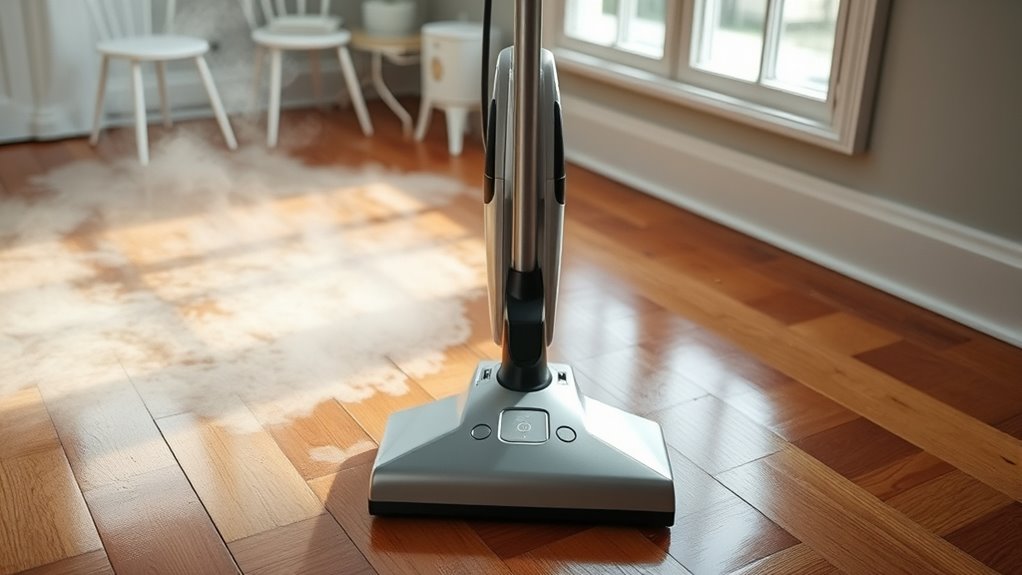
Steam cleaning can seem like a miracle solution for floor maintenance, but it comes with significant limitations.
For instance, it’s not suitable for unsealed wooden surfaces, as the high temperature and moisture can warp and damage them. You also need to be cautious with other types of flooring like luxury vinyl and traditional laminate, which may suffer similar fates. Additionally, improper cleaning techniques can lead to poor air quality, as excessive steam may release harmful particles into the air. Regular home cleaning practices should still be employed to ensure a truly clean environment.
Excessive steam can lead to moisture buildup, promoting mold and mildew growth, which can be particularly concerning for indoor air quality. Plus, steam mops aren’t designed for large spills, so you’ll still need a traditional mop or vacuum.
Finally, the effectiveness of steam cleaning in killing bacteria varies by model and pad, and it mightn’t be as effective as using good old soap and warm water. Additionally, maintaining proper ventilation is crucial during steam cleaning to prevent any harmful gas buildup in the environment.
Best Practices for Steam Cleaning
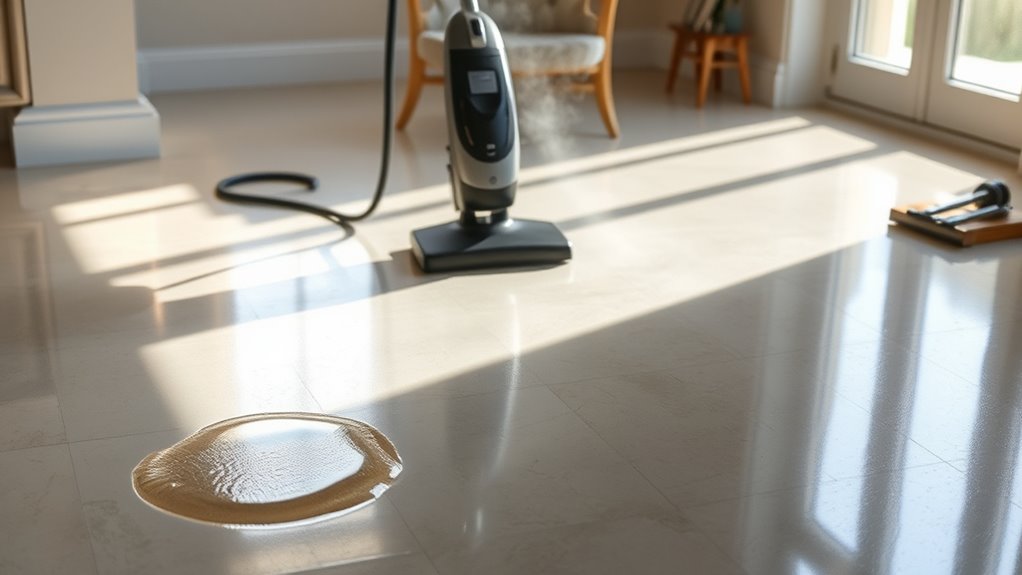
To maximize the benefits of steam cleaning while minimizing potential drawbacks, it’s important to follow some best practices.
Start by sweeping or vacuuming the floor to remove loose dirt and debris, guaranteeing your steam mop works effectively. This preliminary step enhances the effectiveness of the cleaning process and aligns with the principle of goal setting to achieve a cleaner home.
Use distilled water in your steam mop’s reservoir to prevent mineral buildup, especially in hard water areas. Dual-flush toilets are an example of how the right choice in cleaning appliances can promote efficiency in your home. Additionally, consider incorporating energy-efficient designs in your home to further enhance sustainability.
Before diving in, test an inconspicuous area of the flooring to verify it can handle steam without damage.
Keep multiple clean mop pads on hand to switch out during cleaning, so you don’t smear dirt back onto the floor.
Finally, always follow the manufacturer’s instructions for filling, emptying, and maintaining your steam mop for peak performance and longevity. Additionally, consider using high-efficiency models for your steam mop to ensure optimal cleaning results and energy use.
Types of Flooring Suitable for Steam Cleaning
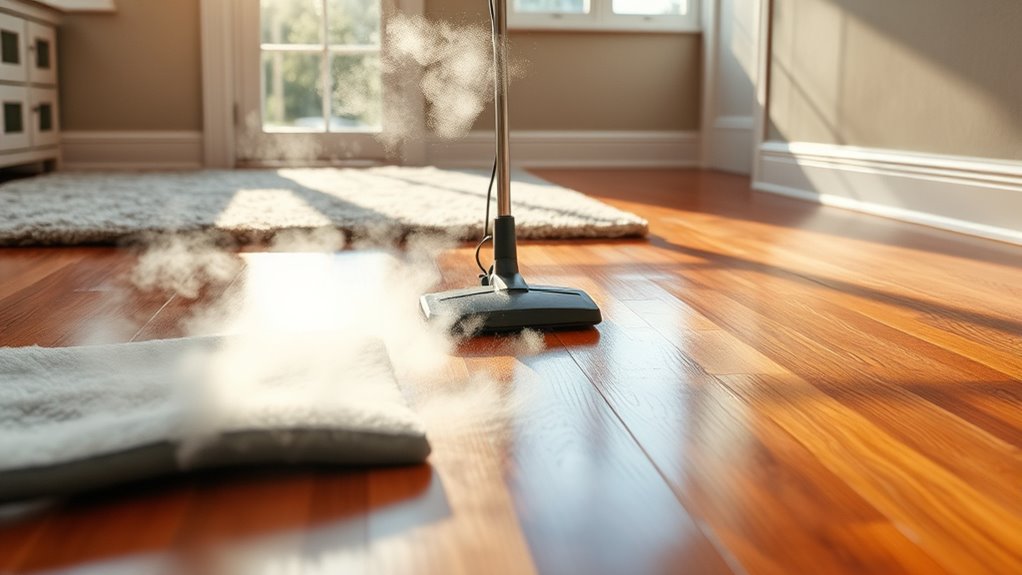
When it comes to steam cleaning, not all flooring types are created equal. Hard surfaces like ceramic and sealed hardwood can handle the heat, while others, like unsealed wood or traditional laminate, should be avoided. It’s important to know which materials are safe to guarantee your floors stay in great shape. For instance, using steam cleaning on distressed finishes may cause damage, as the moisture can warp or deteriorate the wood over time. Additionally, understanding the mental and emotional benefits of maintaining clean and organized spaces can motivate homeowners to choose appropriate cleaning methods for their floors. Regular maintenance of flooring can enhance indoor air quality, promoting a healthier living environment for everyone in the home.
Hard Surface Compatibility
While many homeowners appreciate the efficiency of steam cleaning, it’s crucial to know which hard surfaces can handle the process without damage.
Ceramic and porcelain tiles are perfect candidates, as they withstand high temperatures and steam pressure.
Sealed hardwood floors can occasionally be steamed, but be cautious; too much moisture can lead to water damage, so limit the frequency and verify proper sealing.
Laminate flooring should only be steamed if it’s specifically labeled as water-resistant; otherwise, you risk warping.
Avoid steam cleaning vinyl flooring, including luxury options, as steam can warp or damage the surface.
However, granite and quartz countertops are safe for steam cleaning, providing a chemical-free way to sanitize your kitchen surfaces effectively.
Soft Surface Considerations
If you’re considering steam cleaning your soft surfaces, it’s important to know which types of flooring can handle the heat and moisture.
Steam cleaning is great for carpets and upholstery, especially with the right attachments, as it effectively eliminates allergens like dust mites and pet dander. You can also safely steam clean curtains and mattresses, removing odors and revitalizing fabrics without harsh chemicals.
However, not all soft surfaces are suitable; always check manufacturer guidelines to avoid damage. Regular steam cleaning can enhance the lifespan and appearance of your soft surfaces, but it’s best paired with routine vacuuming to remove loose dirt and debris first.
Comparing Steam Cleaning to Traditional Methods
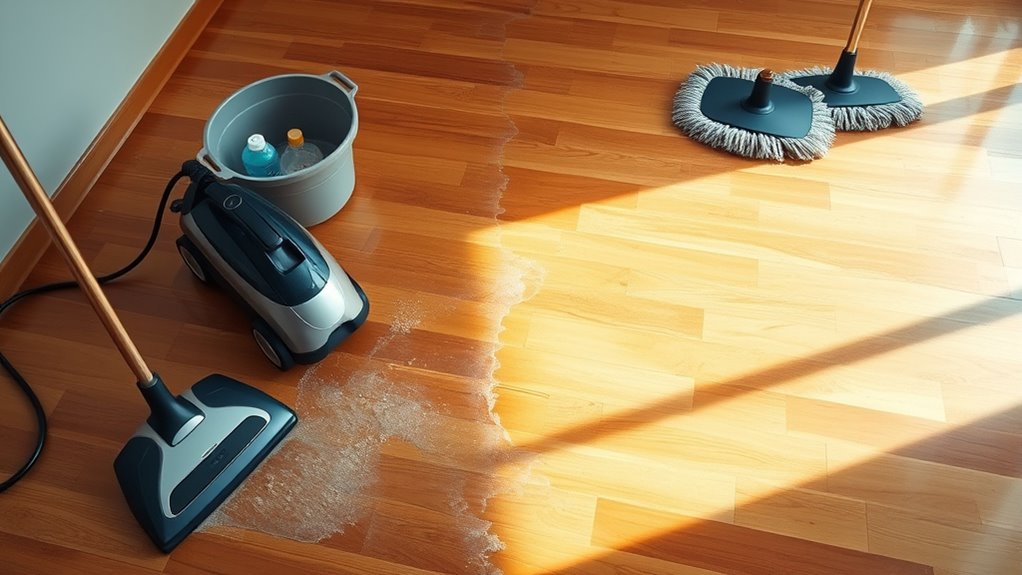
Comparing steam cleaning to traditional methods reveals significant differences in effectiveness and convenience. Steam mops use high-temperature vapor to sanitize and remove grime, while traditional mops rely on cleaning products and dirty water, making them less effective. Although traditional mops are cheaper and don’t need electricity, they can be labor-intensive and require frequent replacement. Steam mops dry faster and are often more durable, though they are unsuitable for certain surfaces.
| Feature | Steam Mops | Traditional Mops |
|---|---|---|
| Cleaning Method | High-temperature steam | Detergents and dirty water |
| Effectiveness | Deep cleaning and sanitizing | Less effective for tough stains |
| Initial Cost | Higher | Lower |
| Surface Compatibility | Limited (e.g., not for unsealed wood) | Widely compatible |
| Drying Time | Faster | Slower |
Frequently Asked Questions
What Is the Downside of a Steam Mop?
The downside of a steam mop is that it can damage certain flooring types, like unsealed hardwood and laminate, which might void your warranty.
You also have to deal with the hassle of finding an electrical outlet, limiting your mobility.
If not filled or tightened properly, it can leak, causing water damage.
Plus, improper use may lead to oversaturation, increasing the risk of mold and mildew.
What Are the Downsides of Steam Cleaning?
Steam cleaning sounds like a magical solution, but it can turn your floors into a disaster zone!
If you’ve got unsealed hardwood or laminate, you’re risking serious damage and possibly voiding warranties. Excess moisture could release mold and mildew, leaving your home smelling musty.
Plus, if your floors have tiny cracks, you might face swelling or separation.
And don’t forget, you’ll be tethered to a power outlet, making it a hassle for larger areas!
Is It Better to Mop or Steam Clean Floors?
When deciding whether to mop or steam clean your floors, consider your specific needs.
If you want a deep clean and quick drying time, steam cleaning’s high-temperature steam can effectively sanitize and remove stains.
However, if you’re focused on large spills or sensitive surfaces, a traditional mop might be better.
It’s all about the balance between thoroughness and care for your flooring.
Choose the method that aligns best with your cleaning priorities.
Where Does the Dirt Go When You Steam Clean?
Oh, you thought steam cleaning was a magic trick that makes dirt disappear? Well, it’s not Hogwarts!
When you steam clean, the high-temperature steam loosens dirt and grime, which gets absorbed into the mop pad. That’s where all the dirt goes, making the pad a little monster of filth!
Just remember to change it regularly, or you’ll be spreading dirt instead of banishing it. So, keep that mop pad fresh to truly clean your floors!
Conclusion
To sum up, steam cleaning offers a powerful, eco-friendly way to sanitize your floors, making them shine without harsh chemicals. It’s quick, efficient, and can tackle tough stains with ease. However, it’s important to remember that not all floors are suitable, and overuse can cause damage. So, weigh the benefits and limitations carefully. By choosing the right method for your needs, you can enjoy clean, fresh floors that enhance your home’s beauty and cleanliness.

